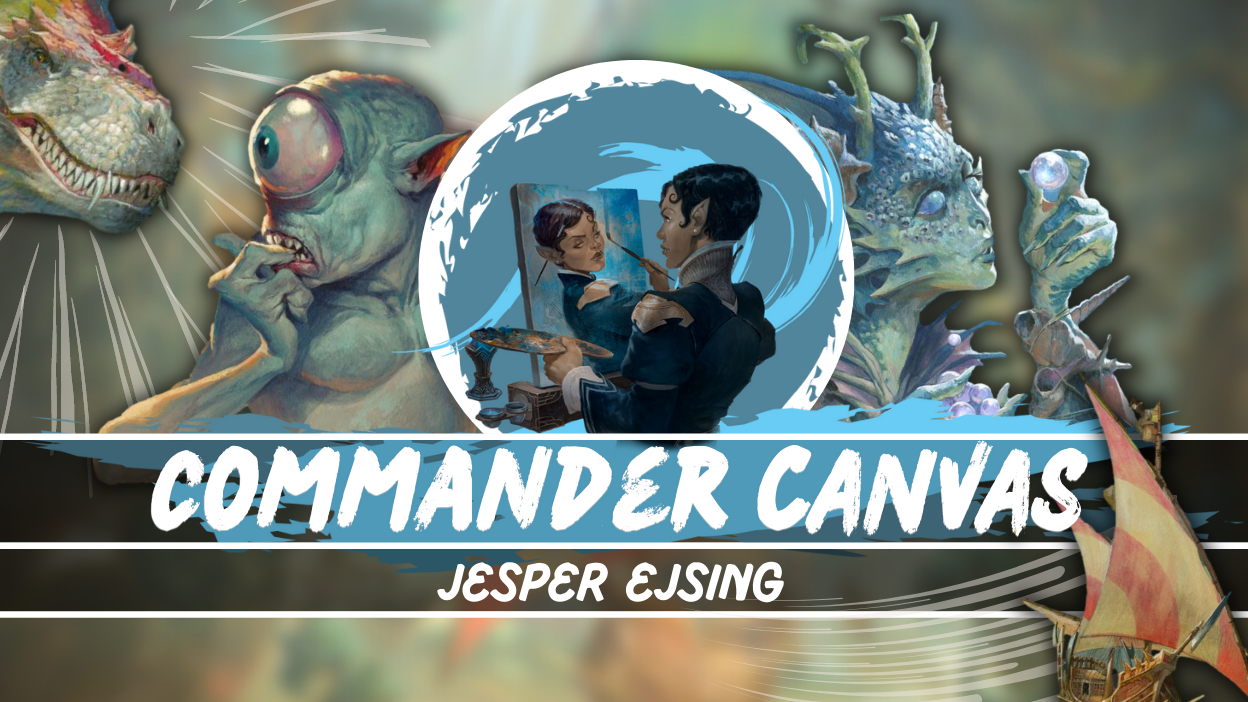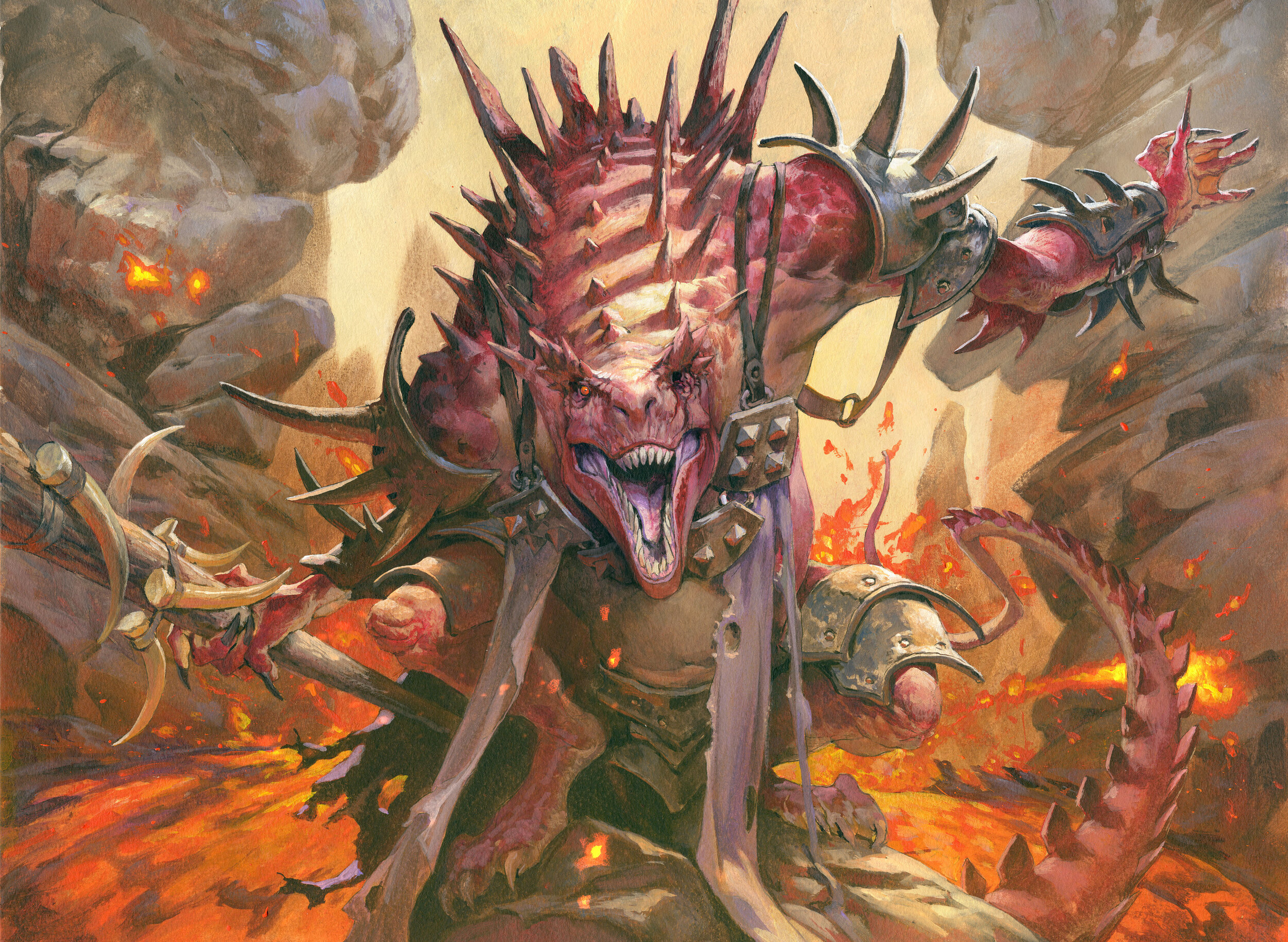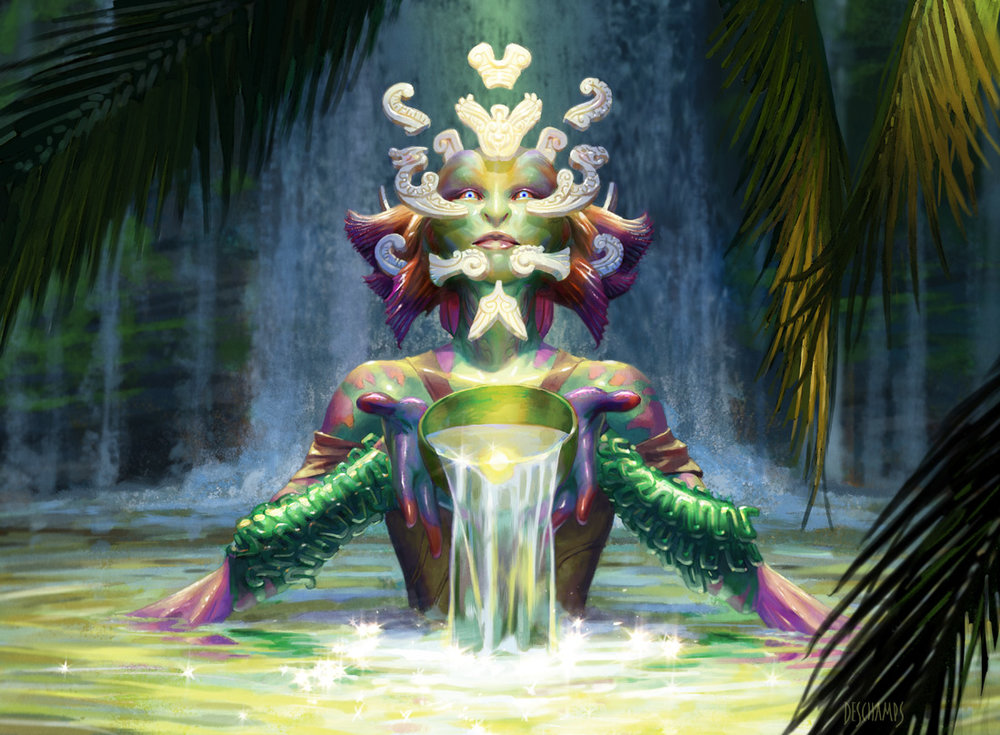Commander Canvas: Jesper Ejsing

Painting Commander
There have been more than 400 artists who have illustrated a Magic: the Gathering card. Many of them view the game as more than just a client, however. Of those artists, dozens are also avid Commander players. On this week's Commander Canvas, we chat with Jesper Ejsing, an artist responsible for more than 200 cards, tokens, schemes, and planes.
Previous entries in Commander Canvas feature Evyn Fong, Jehan Choo, Ovidio Cartagena and Rope Arrow.
Needs More Spikes

"Being a Magic card artist was a dream for me," said Jesper Ejsing.
That dream came true in 2007, with Ejsing tapped to illustrate five cards featured in that year's Lorwyn expansion: Boggart Loggers, Hunter of Eyeblights, Weed Strangle, Changeling Titan, and Guardian of Cloverdell. Ejsing's brand of dark whimsy has become a staple in the game ever since.
Ejsing's first exposure to Magic was at an RPG convention in Odense, Denmark, where he was studying Danish literature at a local university. Ejsing wasn't alone in seeing the game for the first time: it was 1993, and Magic was in its infancy. "Some guys were playing this strange card game," he said, and his interest was piqued. A few weeks later, a friend of his offered to teach Ejsing the game he later learned was called Magic. "He took me to a bookstore to buy some boosters and a starter deck," he said. "I bought some Antiquities and Arabian Nights boosters to fill out my starter deck, and went home to learn."
His enthusiasm for the game proved to be infectious, and soon enough he'd convinced three more friends to take up the game, with the group buying more cards to supplement their collections. "The store ran out of Arabian Nights boosters and when we asked them when there were more coming of them, they told us they were not gonna be back. All was sold out," he said. "That was when it hit us: this was limited and we bought all we could."
Although his well had run dry, Ejsing said he was able to build a mono-black deck, and at this time, he added, there was no four-card limit for Constructed decks. "I only had one Sengir Vampire, but five Demonic Tutors so I could always find it," he said. "The format we played was just...'Magic.' You more or less just played with all the cards you had."
The year after, he was back at the same RPG convention in Odense, and this time, the event was host to a Magic: the Gathering tournament. During the intervening year, the concept of a "format" along with standardized play had begun to solidify, and Ejsing said most players were building and playing under the constraints of a 60-card deck and a four-card limit, as well as restricted cards lists, meaning only one copy was allowed in a deck. Some cards that found themselves on the restricted list in 1994 that no longer are include Berserk, Ali from Cairo, and Rukh Egg (that last one was a "devastating" combo with Wrath of God). Other cards restricted in 1994 that remain on restricted lists are more obviously game-warping, like the Power 9 and Sol Ring.
Ejsing entered into the tournament with his mono-black deck, which now featured his "signature card" of Icy Manipulator, which he combined with Royal Assassin. Among his friends, this combo earned him the moniker of "Ejsing Manipulator." With his mono-black deck, he battled his way to the final round of the tournament before he was defeated by another player piloting a mono-red deck. Ejsing describes that final match:
But one game specifically from that first tournament stood out to me: an opponent of mine was playing a lockdown deck and had my vampire tapped down with a Meekstone. We were doing a draw-go situation with none of us able to do the other guy harm, [but] I had him down to four life already from early beatdown. Then I saw my Island of Wak-Wak, a card I only played to neutralize others' Serra Angels. But when it dawned on me that I could use it on my own vampire to be able to untap it, I got such a great feeling, thinking "Ohhhh, this game is insane." And I still remember my opponent's face when I gave my own vampire 0 power in my untap step and untapped it. He, too, never had used Wak-Wak on his own creature before. It sounds stupid today, but back then we were not used to using cards in different ways than they were meant to be used -- the creativity was not there yet.
Today, Ejsing's been a Magic artist for more than 15 years, and he's been a part of numerous design teams, assisting in developing the visual identity for a number of worlds in the game, and he still loves the game as a player, slinging spells whenever the opportunty arises and time allows. Since his first batch of cards in Lorwyn all those years ago, Ejsing's amassed a considerable portfolio of some of the most iconic cards over the past decade. He's provided the art for many Commander staples, including Reliquary Tower, Thassa's Oracle, Thornbite Staff, Lignify, and Hedron Crab. He's also done art for more than two dozen legendary creatures, including Koma, Cosmos Serpent, Fblthp, the Lost, Yurlok of Scorch Thrash, Willowdusk, Essence Seer, and Baron Von Count. Further, there's also one particular card that has developed a life of its own.
Being an avid player in addition to a veteran artist of the game has provided Ejsing a unique perspective when taking on illustrations. "It helps me on a flavor side I think. I know what a stompy green creature should look like. But mostly I think it helps me in making decisions in creating art," he said. "I ask myself often when starting a new painting: 'is this really a red card, this monster I drew'? 'Nahhh, needs more spikes.'"
An Enchanted Evening

Jesper Ejsing's well-known among Magic artists for being a formidable Commander player.
Currently, his go-to deck is a Tuvasa the Sunlit Enchantress list, a deck he said "has a history" in his playgroup. Among his usual opponents, Ejsing's known as an aggressive player, as well as the one guilty of pushing the power level of the decks within his group. "We reach a point where I was always targeted and felt like I was constantly the threat," he said. "I needed a break from that image, and my friend Adam Sund teased me and said 'you cannot make a deck with blue and not play countermagic.'" That was a limitation Ejsing had never tried, so he viewed it as a challenge, building what became his Tuvasa deck. "The Enchantress theme has always been a favorite of mine, but always centered around green/white," he said. "I wanted to include blue in order to be able to exploit Enchanted Evening."
The deck's gone through many stages, but one thing Ejsing has focused on is allowing for the deck to have no "single, linear way" of winning. He said he wanted the deck to be solely synergistic, and one that could "surprise him" every time he sat down at a Commander table. "This was a reaction to having built and played many decks that bored me after having played them once or twice and just figured that they won the same way all the time," he said. "With this deck, I wanted to build something that would be fun for me to play every time, and one that my opponents would find fun and interesting to play against too, because they would never play against the same win condition two games in a row."
As an Enchantress deck, Ejsing's Tuvasa deck utilizes "Enchantress" effects to draw cards from playing enchantments. The focus is on that engine, and Ejsing described it as a "card draw snowball" that uses card advantage to generate a dominating board presence quickly while still being resilient. "It can win out of nowhere and can easily build a huge army in one turn and attack at once via Concordant Crossroads," he said. "Things that it can do sneakily is use Enchanted Evening and Aura Thief and a sacrifice effect to steal all opponents' permanents."
The deck also features the classic combo of Earthcraft + Squirrel Nest, as well as less-obvious lines of play, like using Beast Within (a card that Ejsing himself has illustrated a version of) to destroy his own Academy Rector to cheat in Omniscience. "I like to draw lots of cards and in low mana curve, so I can chain two to three cards together at a time for an explosive effect," he said. "I Like to cheat big threats into play, I like to fill the board with permanents and go insane in one big turn out of nowhere. I like to lock down my opponents and crush them without a chance to defend themselves. This deck does it all. I like how the deck surprises me while playing it and how it forces me to piece a puzzle together according to what's happening on the board."
Even before Commander was a format, Ejsing said he's always had a close relationship with Enchantress decks. In those days, he was playing a Standard Enchantress deck and noticed a combo with Auratog, Rancor, and an Enchantress in play. "I was sure I had found something no one else had and that I was a Magic: the Gathering genius, because none of my other friends were doing this trick," he said. "I found out later it was something everyone knew. Well, I still play that combo in my Tuvasa deck, and Auratog does many other needful things other than sacrificing Rancor. With Enchanted Evening in play, I can sac Aura Thief to him, or I can sack Opalescence in response to a board wipe."
There's also the myriad ways Ejsing likes to take advantage of Enchanted Evening. "Enchanted Evening makes all your lands and creatures enchantments too, so Tuvasa can easily do 21 commander damage in one turn too," he said. "Basically, what I love about the deck is the many different ways it can play. It can do token army, Voltron, destroy or steal all opponents' things. It can do a lot, and most cards are good by themselves, but put together in synergies they shine the brighter." The only weak point to the list, he said, is when the enchantressses get killed, or aren't found early in the game. "If your opponents keep the card-draw ball from rolling the deck crumbles," he said. "I have kept the deck mana curve very low, and most enchantments as global enchantments rather than Auras to not lose card advantage."
To see Ejsing playing a version of his Tuvasa list, check out his appearances on MTG Muddstah's YouTube channel. During the COVID-19 pandemic, Ejsing played frequently on Muddstah's channel and also appeared on The Command Zone, but said he mostly plays among his private playgroup. Whenever he attends conventions, though, it's with a few Commander decks in tow and always tries to join in on some games. "But to be honest, it is too little playtime going around these days," he added.
Impact Resonance

With so many cards illustrated during his career as a Magic artist, Ejsing's got one rule that few Commander players could have: "I always play at least one card I've painted in every deck."
In Tuvasa, there are actually several, he said, from Swords to Plowshares and Beast Within to Lignify and Yavimaya Coast. He added that with a recently released Ejsing version of Mystic Remora, that card will likely find its way into the list as well. His personal connection with the deck is that it is very much his own build. Ejsing said there are "so many stronger versions" of the deck out there, but in his opinion they're not as fun. "Tuvasa Stax or a full pack of free counterspells would definitely make it a better deck," he said. "But the deck is not supposed to be a borderline cEDH deck, it's my deck, and it has developed to what it is through many games and iterations. I guess thats what make it personal."
Being able to put a personal touch on his decks is something that Ejsing is certainly consious of, especially when it comes to foils, showcase treatments, artist proofs, and artist alters. "I hate all of those things," he said. "I am an old-school player and like the first version of a card. Having all these different alternative art versions makes it hard to see what the other players are playing when the card picture on the Necropotence is not the same as the one you are playing." And when it comes to altered cards, "it's even worse," he said. "You have no chance of remembering the image from anywhere, but gotta ask all the time what card it is you have in play."
As an artist and a player, Ejsing said that often, it's not so much that he creates a piece of art for a card and hopes it'll be playable in a deck, but rather the other way around. "When we paint the cards, we almost never know what the card does," he said. "So it's not until the spoiling of the set that I find out if this card I painted is good or bad or if it fits into any deck I am already playing. But sometimes, especially with reprints like Swords or Fish or basic lands, I know I am gonna switch them in all decks with my own versions."
And with so many Ejsing versions out there of cards, he said he's done exactly what one might suspect: "I actually made a Commander deck with All-Ejsing Cards," he joked. "It's a Sek'Kuar, Deathkeeper deck and it stinks." To be fair, though, players can utilize a fairly strong all-Ejsing combo, should they wish, in Tooth and Nail to fetch into Ayula, Queen Among Bears and Changeling Titan. "Boooyah!" added Ejsing.
To learn more about Jesper Ejsing's art, visit his website. Versions of his art are available for purchase in a number of forms, including playmats, prints, and even mobile phone covers. Ejsing has also published a collection of his fantasy art, titled Elsewhere, that can be purchased here. He can also be found on Instagram.
